Like many places where time exists in abundance, the countryside village I grew up in was full of competitions. The community calendar involved a steady stream of raffles, duck races, stone-skimming championships, and make-your-own-miniature-garden contests (one year I took second place for an allotment lined with a lolly stick fence and sewn with Leylandii seed cabbages). The competitive high point of the year was the summer fête. There, laid out on trestle tables in the village hall, one could peruse the handiwork of the village’s most ambitious gardeners: fat courgettes, pale onions, a green chorus line of leeks. Then there were the flowers. There were prizes for the best rose and biggest sunflower. The table centrepiece category featured a glut of dahlias, sweet peas, scabious, and gladioli, each stem freshly plucked and standing to attention as the judges made their rounds and awarded rosettes.
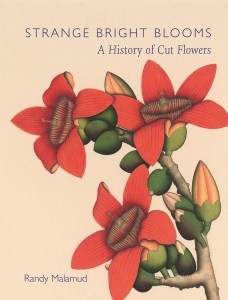 While reading Randy Malamud’s Strange Bright Blooms, I found myself wondering what the author would have made of this scene, with its air of parochial whimsy and its hyper-local focus. I think he would have loved it. Malamud is a self-confessed floraphile. His book, which is ostensibly a history of cut flowers but in actuality more of a ramble through the role of flowers both real and symbolic in the realms of literature, art, commerce, identity, and war, takes its title from an Emily Dickinson poem where ‘some little Arctic flower’ goes wandering around the world ‘until it puzzled came/ To continents of summer – / To firmaments of sun – / to strange, bright crowds of flowers – / and birds, of foreign tongue!’ Malamud sees in Dickinson a kindred ‘flower-poetic spirit’, admiring her fascination with botany and her exuberant, off-kilter use of language (in this book it is a good thing to be linguistically ‘flowery’). More deeply, he identifies in her work an ethic of flowers he wishes to encourage in others, questing to discover ‘what sorts of wisdom Dickinson’s strange, bright crowds of flowers can provide to strange, bright crowds of people’. This transforms his book from a straightforward history into a quasi-guidebook, driven not only by an interest in how we have ritualised and responded to flowers but a desire to learn from the floral world and treat it with due reverence.
While reading Randy Malamud’s Strange Bright Blooms, I found myself wondering what the author would have made of this scene, with its air of parochial whimsy and its hyper-local focus. I think he would have loved it. Malamud is a self-confessed floraphile. His book, which is ostensibly a history of cut flowers but in actuality more of a ramble through the role of flowers both real and symbolic in the realms of literature, art, commerce, identity, and war, takes its title from an Emily Dickinson poem where ‘some little Arctic flower’ goes wandering around the world ‘until it puzzled came/ To continents of summer – / To firmaments of sun – / to strange, bright crowds of flowers – / and birds, of foreign tongue!’ Malamud sees in Dickinson a kindred ‘flower-poetic spirit’, admiring her fascination with botany and her exuberant, off-kilter use of language (in this book it is a good thing to be linguistically ‘flowery’). More deeply, he identifies in her work an ethic of flowers he wishes to encourage in others, questing to discover ‘what sorts of wisdom Dickinson’s strange, bright crowds of flowers can provide to strange, bright crowds of people’. This transforms his book from a straightforward history into a quasi-guidebook, driven not only by an interest in how we have ritualised and responded to flowers but a desire to learn from the floral world and treat it with due reverence.
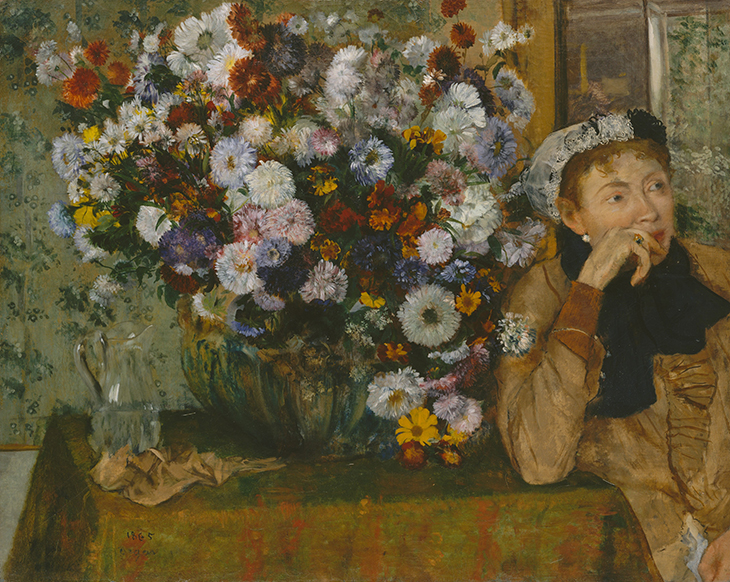
A Woman Seated beside a Vase of Flowers (Madame Paul Valpinçon?) (1865), Edgar Degas. Metropolitan Museum of Art, New York
Mrs Dalloway said she would buy the flowers herself. T.S. Eliot wrote about lilacs springing from dead land. Georgia O’Keeffe was forever being asked if her enlarged paintings of irises and jimson weeds were sexual. Robert Mapplethorpe and Imogen Cunningham photographed flowers in close up, creating sensuous, stark lines. Oscar Wilde wore a green carnation as a coded badge of homosexuality. Diego Rivera depicted the realities of Mexican flowers sellers in his paintings of women carrying calla lilies. Freud interpreted a patient’s dream about red camellias as a symbol for menstruation. Ruskin thought that ‘flowers seem intended for the solace of ordinary humanity’.
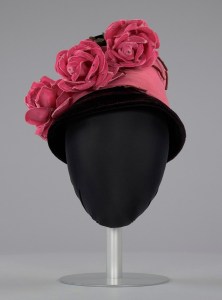
Black and pink beehive hat with pink flowers (1941–1994), Mae’s Milinery Shop. The Smithsonian National Museum of African American History and Culture
Artists, writers, and thinkers have always been compelled by flowers, attempting to understand them, recreate them in detail, and use them to signal everything from hope to eroticism to subversion. Unlike a bouquet, which satisfies a fleeting desire for beauty and often says something to the recipient (‘I’m sorry’, ‘I love you’, ‘congratulations’, ‘I don’t have the words’), art offers a particular benefit: preservation. All flowers are fleeting in their beauty, but a cut flower brings with it a particularly acute awareness of time. If you capture a flower well, it will never die. In Strange Bright Blooms, Malamud writes perceptively about the visual and verbal rendering of flowers. His research is wide-ranging, sending the reader off into all manner of artistic terrains. Accompanying illustrations show Jan Brueghel the Elder’s radiant still lifes of flora that can never have bloomed at the same time, Chen Hengke’s painted fans featuring narcissi and orchids, Jeff Koons’ bloated Bouquet of Tulips sculpture, and Mae Reeves’ millinery festooned with pink velvet blooms.
Later chapters are devoted to the globalised supply chain of flowers, and the murky – and sometimes straightforwardly nasty – ways in which flowers have become tangled up in misogyny, racism, and inequality. The cut flowers industry is now a $75–$100 billion global business, and the average import distance for flowers is 4,800km. As with many similarly sized industries, it is awful for the environment and predicated on unethical working conditions. In this context, Malamud reads our contemporary wish for year-round fresh flowers as ‘a manifestation of […] hubris’, with our ability to pick them up in a supermarket or order them to our doors overnight creating a deep alienation from the places and people that bring these blooms into being.
This is not an argument unique to flowers. Questions of convenience and opaque, far away production methods are ever-present for the modern consumer; we have little idea where most of the things we surround ourselves with are made. This idea seems to particularly pain Malamud, given that the central thesis of this book is grounded in the potential solace (to borrow Ruskin’s word) offered by flowers.
Whether it’s Wordsworth and his dancing daffodils or the unexpected pleasure of an armful of hydrangeas, we frequently find ourselves transfixed by flowers. But Malamud’s unease with accepting their darker side, not only materially and culturally, but also emotionally is puzzling. Earlier on, he writes about Sylvia Plath’s poem ‘Tulips’ (1961), which concerns the speaker’s period of time recovering from hospital. It is winter and the tulips in the room are ‘too excitable’ for someone who desires only emptiness. She is overwhelmed by their ‘sudden tongues and their colour’, their ‘redness [which] talks to my wound’. Malamud deems it ‘perhaps the most unpleasant flower poem ever’ – drenched in ‘unrelenting cynicism’ and using ‘an innocuous bouquet of flowers’ for its own, intense ends. His conclusion that flowers ‘don’t do this’ (i.e. cause pain, whether sensory or otherwise) is not just naïve, but incorrect. Flowers are not always our friends.

Bouquet in a Clay Vase (c. 1609), Jan Brueghel the Elder. National Gallery, London
One of the most interesting things about nature, whether part of the landscape or embodied by intrusive red tulips in a white hospital room, is its potential not only for beauty but cruelty too. When I think of my village fête and its bucolic vases full of homegrown flowers, I am still charmed. But countryside life also requires a certain acceptance of the natural world’s unpleasantness.
Strange Bright Blooms acknowledges the potential ugliness of flowers – in their production and poisons, and as emblems of violence as well as peace – but still maintains a sort of moral certainty about what they could be, if given the chance. This is a strange and bright book, alive to floral beauty and revealing for the connections it makes between flowers in art, science, commerce, and culture. But Malamud’s desire to his subject ‘from ourselves’ sits oddly within this thicket of ideas, as though the author were continually trying to return us to an Eden that never really existed.
‘Strange Bright Blooms: A History of Cut Flowers’ by Randy Malamud is published by Reaktion Books.
Unlimited access from just $16 every 3 months
Subscribe to get unlimited and exclusive access to the top art stories, interviews and exhibition reviews.

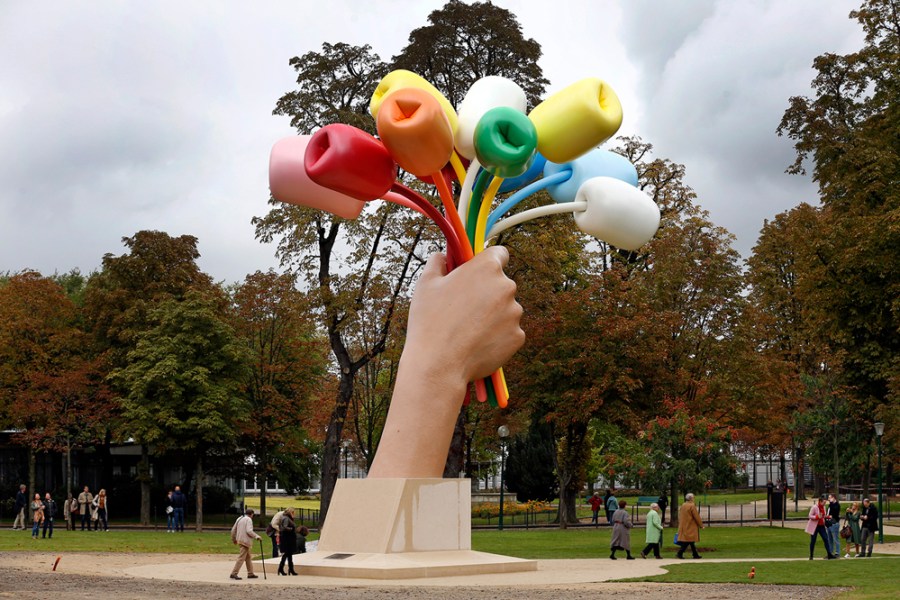
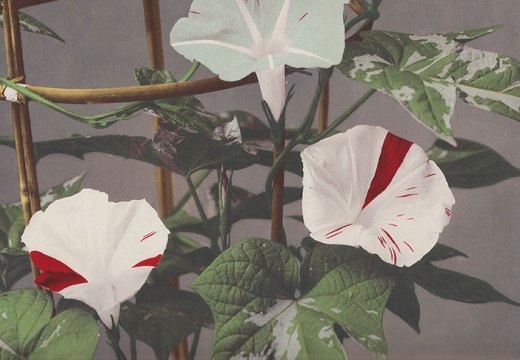
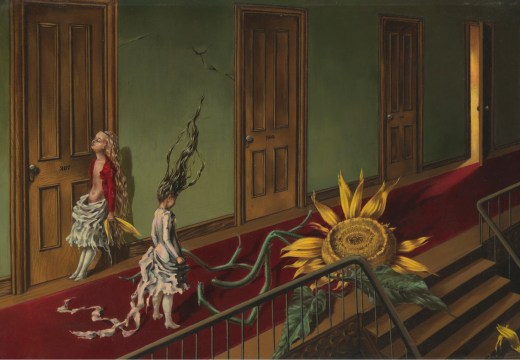
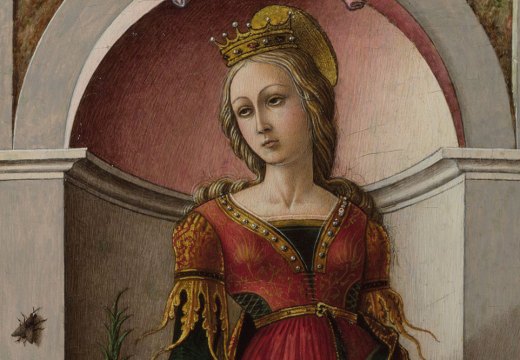









![Masterpiece [Re]discovery 2022. Photo: Ben Fisher Photography, courtesy of Masterpiece London](http://www.apollo-magazine.com/wp-content/uploads/2022/07/MPL2022_4263.jpg)
It’s time for the government of London to return to its rightful home